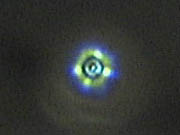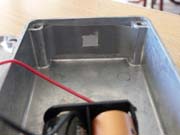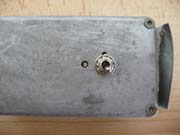I used an alloy project box which I had in my parts bin, but a plastic box would do equally well. The first thing to do is drill a hole at one end of the main body of a suitable size for the pinhole assembly.
The pinhole was made in a piece of Aluminium kitchen
foil. To hold the foil in place I simply cut a hole in a
suitably sized piece of duct tape, and stuck a piece of foil
on that, prior to making the pinhole.
To get the smallest possible hole I found it best to lay the
foil flat on a board, then just tap it lightly with the
point of a fine needle. Then I stuck the assembly to the
inside of the box.
This design means that should the pinhole get damaged it's easily replaced.
The hole I drilled in the bottom is tapped 1/4" for a tripod camera thread. This would not be practical for a plastic box, but possibly hook and loop tape could be used for fixing.
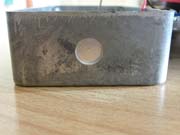
For the light source I used a miniature high brightness 3
volt white LED (Maplin part no. N21FN). A small toggle
switch (FH00A) to control it and to vary the brightness a
miniature potentiometer (UH26D ) glued in place. Leave
plenty of length on the legs of the LED to allow for
positioning directly in line with the pinhole.
A twin AA size battery holder (YR60Q) completes the job. I
happened to have a similar one available, but of course for
the minimal power requirements AAA batteries (holder JB83E)
will do just as well. The battery holder is held firmly in
place in the box with hook and loop tape. Or of course it
could be glued.
Circuit Schematic. I wired the switch to use two of the terminals as supports for the LED.
In practice, I found the potentiometer was hardly necessary, although because the light is bright enough for daytime use, at night a reduction in brightness could be beneficial. For the 3 volt LED only a few turns of the 22 turn 50K potentiometer is enough to dim the light considerably.
A piece of duct tape to protect the pinhole when not in use, and job done!
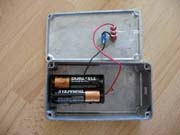
The only drawback - yes there is one! is that the vast majority of astronomical telescopes are designed to focus at or near infinity. So it is necessary to set up the artificial star a good distance away from the telescope. For many 'scopes this might be as much as 100 metres or more, so it is useful to have a helper!
But anyway, unless the pinhole is *really* tiny, the unit needs to be at least 50 metres away from the telescope to be properly effective. I believe my pinhole to be in the region of 1/4 mm. That is equivalent to 1 arc-second at 50 metres, or of course 0.5 arc-sec at 100 metres - at the limit of resolution of a 10" amateur telescope.
Mounted stably on a tripod, the star does a good job. This is a slightly out of focus refractor diffraction pattern imaged using a webcam. Even across a field on a cloudy day there was some turbulence, but clearly the instrument is well collimated.

